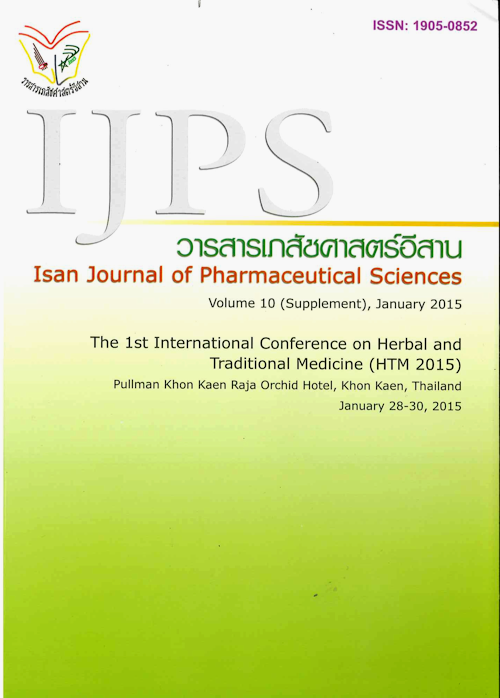Modulation of Plumbagin Production in Plumbago zeylanica Using a Single-chain Variable Fragment Antibody Against Plumbagin
Main Article Content
Abstract
Introduction: Plumbagin (PL) is a naturally occurring yellow pigment manly isolated form the
genus Plumbago (Plumbaginaceae) and recently been attracted much attention due to their various
pharmacological activities. In this study, production in hairy root of Plumbago zeylanica (P. zeylanica)
was accelerated by an anti-PL single-chain variable fragment antibody (PL-scFv), which possesses
highly specifi city to PL. Method: Recombinant Agrobacterium rhizogenes (ATCC 15834) containing
a PL-scFv were obtained through triparental mating and transformed into P. zeylanicato induce PL-scFv
protein in the hairy roots. Results: Up to 40 μg recombinant PL-scFv were expressed per milligram of
soluble protein in transgenic P. zeylanica hairy root cultures. The mean PL content obtained from
transgenic hairy roots (12.24 μg/100 mg dry weight) exhibited 2.2 times higher than those obtained
from wild-type (5.48 μg/100 mg dry weight). When the expression level of PL-scFv and PL content
were analyzed by indirect and indirect competitive enzyme-linked immunosorbent assay, they were
positively correlated (r2=0.885), which suggest that the PL biosynthesis pathway had been modulated
by the expression of PL-scFv protein in the hairy roots of P. zeylanica. Conclusion: The metabolic
engineering using scFv, as performed in this study, is useful technique because production of pharmacologically
active compounds can be enhanced without producing a biosynthetic enzyme.
genus Plumbago (Plumbaginaceae) and recently been attracted much attention due to their various
pharmacological activities. In this study, production in hairy root of Plumbago zeylanica (P. zeylanica)
was accelerated by an anti-PL single-chain variable fragment antibody (PL-scFv), which possesses
highly specifi city to PL. Method: Recombinant Agrobacterium rhizogenes (ATCC 15834) containing
a PL-scFv were obtained through triparental mating and transformed into P. zeylanicato induce PL-scFv
protein in the hairy roots. Results: Up to 40 μg recombinant PL-scFv were expressed per milligram of
soluble protein in transgenic P. zeylanica hairy root cultures. The mean PL content obtained from
transgenic hairy roots (12.24 μg/100 mg dry weight) exhibited 2.2 times higher than those obtained
from wild-type (5.48 μg/100 mg dry weight). When the expression level of PL-scFv and PL content
were analyzed by indirect and indirect competitive enzyme-linked immunosorbent assay, they were
positively correlated (r2=0.885), which suggest that the PL biosynthesis pathway had been modulated
by the expression of PL-scFv protein in the hairy roots of P. zeylanica. Conclusion: The metabolic
engineering using scFv, as performed in this study, is useful technique because production of pharmacologically
active compounds can be enhanced without producing a biosynthetic enzyme.
Article Details
Section
Invited Speaker
In the case that some parts are used by others The author must Confirm that obtaining permission to use some of the original authors. And must attach evidence That the permission has been included


